Hello dog lovers. Today Allergic Otitis in Dogs is my topic . Here I will explain in detail what it is, its causes, signs and symptoms, its prognosis, and at the end, I will explain its different methods of prevention and treatment.
Hello everyone who loves dogs! I’m Dr. Arif Aziz, and I’ve been taking care of pets especially dogs at my clinic for a long time, exactly 14 years! I’m here to share some valuable information with you that I’ve gathered from books during my study time written by experts in veterinary medicine (DVM) and MSC (Master of Science), as well as from my own experiences working with dogs, especially GSD.

Allergic Otitis in Dogs: step by step.
Firstly understand what’s Allergic Otitis.
Think of allergic otitis as a fancy way of saying that a dog’s ears get all cranky and inflamed because they’re allergic to certain things. These allergies can be to stuff like pollen, dust, mold, or even some foods. When these allergens get into a dog’s ears, their immune system reacts, causing irritation and inflammation off the ear.
Now Understand the Ear Anatomy of Dog:
- External Ear:
- This is the part you see on the outside, the floppy or pointy bit that we often scratch behind. It includes the ear flap (pinna) and the ear canal.
- 2. Ear Canal:
- This is like a tunnel that leads from the outside to the middle ear. It’s lined with skin and glands that produce wax to help keep things clean.
- Middle Ear:
- Beyond the ear canal lies the middle ear, which is separated from the external ear by the eardrum (tympanic membrane). It houses delicate structures like the tiny bones (ossicles) that help transmit sound vibrations.
- Inner Ear:
- Deeper inside is the inner ear, which is responsible for hearing and balance. It’s made up of intricate parts like the cochlea for hearing and the semicircular canals for balance.
Now understand How Allergic Otitis Happens:
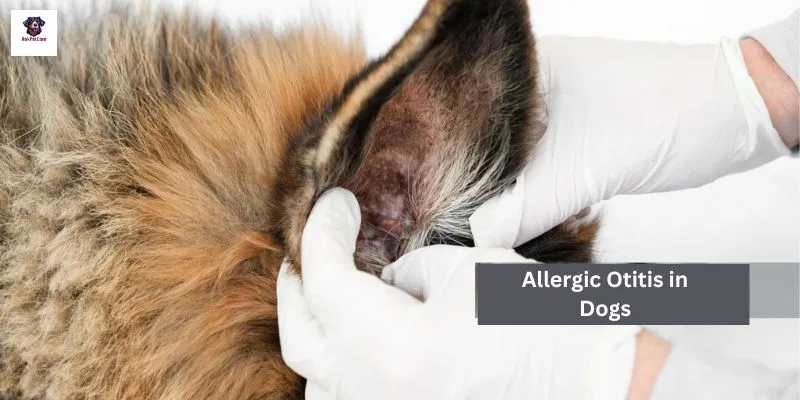
When a dog’s ears come into contact with allergens, especially in the external ear canal, the immune system jumps into action suddenly. The allergic reaction triggers inflammation, causing the ear canal’s skin to become red, swollen, and itchy. This can lead to discomfort and a strong urge to scratch or shake the head.
Now understand Why Understanding Ear Anatomy Matters:
Knowing how a dog’s ears are structured helps us grasp why allergic otitis can be such a bother. The external ear canal, with its sensitive skin, is particularly vulnerable to allergens. Plus, the inflammation can disrupt the delicate balance within the ear, affecting hearing and equilibrium.
my related article.
best-treatment-of-environmental-allergies-in-gsd/.
Now explore What is external and internal otitis.
External otitis and internal otitis are two distinct types of otitis that can affect dogs’ ears. Here’s an explanation of each:
External Otitis:
-
- Definition: External otitis refers to inflammation or infection of the outer ear canal, extending from the ear opening to the eardrum (tympanic membrane).
- Causes: External otitis can be caused by various factors, including bacterial or yeast infections, parasites (such as ear mites), foreign objects lodged in the ear canal, allergies, or trauma to the ear.
- Symptoms: Common symptoms of external otitis in dogs include ear scratching or rubbing, head shaking, ear discharge (which may be pus-like, brown, or black), foul odor from the ear, redness or swelling of the ear canal, and sensitivity or pain when touching the ear.
- Diagnosis: Veterinarians diagnose external otitis through physical examination of the ear canal, microscopic examination of ear discharge (if present), and possibly additional tests such as ear cytology or cultures to identify the underlying cause.
- Treatment: Treatment for external otitis typically involves cleaning the ear canal, administering ear medications (such as antibiotics, antifungals, or corticosteroids) as necessary, and addressing any underlying causes such as allergies or parasites.
-

Allergic Otitis in Dogs
Internal Otitis:
-
- Definition: Internal otitis, also known as otitis media, refers to inflammation or infection of the middle ear, which is located behind the eardrum (tympanic membrane).
- Causes: Internal otitis can result from the spread of infection or inflammation from the external ear canal (external otitis) or other nearby structures. It can also occur secondary to conditions such as dental disease or trauma.
- Symptoms: Symptoms of internal otitis in dogs may include head tilting, loss of balance or coordination (vestibular signs), pain or discomfort, changes in behavior or appetite, and potentially facial nerve paralysis in severe cases.
- Diagnosis: Diagnosis of internal otitis often requires a thorough veterinary examination, which may include otoscopic examination of the ear canal, imaging studies (such as radiographs or computed tomography), and possibly sampling of ear fluid or tissue for analysis.
- Treatment: Treatment for internal otitis typically involves systemic antibiotics or antifungal medications to address the infection, along with supportive care to manage pain and inflammation. In some cases, surgical intervention may be necessary to drain fluid or remove diseased tissue from the middle ear.
Both external and internal otitis can cause discomfort and potentially lead to complications if left untreated, highlighting the importance of prompt veterinary evaluation and appropriate management for dogs experiencing ear problems.
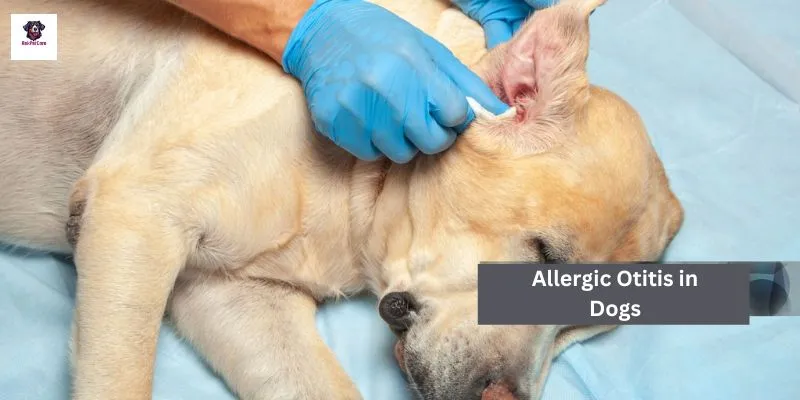
Here’s the information organized into a simple table format:
| Aspect | External Otitis | Internal Otitis (Otitis Media) |
| Definition | Inflammation or infection of the outer ear canal | Inflammation or infection of the middle ear |
| Causes | Bacterial or yeast infections, parasites, allergies, trauma | Spread of infection, inflammation, dental disease, trauma |
| Symptoms | Ear scratching, head shaking, ear discharge, redness/swelling | Head tilting, loss of balance, pain, changes in behavior |
| Diagnosis | Physical examination, ear cytology, cultures | Otoscopic examination, imaging studies, fluid/tissue sampling |
| Treatment | Cleaning ear canal, ear medications, addressing underlying causes | Antibiotics, antifungals, pain management, possibly surgery |
This table simplifies the key aspects of external otitis and internal otitis, making it easier to understand the differences between the two conditions.
Certainly, I understand. Here’s an outline tailored to address common queries on Google or Bing regarding allergic otitis in dogs:
Now understand Why It’s Important for Dog Owners:
Imagine if your dog’s ears were constantly itchy and bothering them. It wouldn’t be very nice, right? Well, that’s what allergic otitis can do to them. So, dog owners must know about it and do something about it.
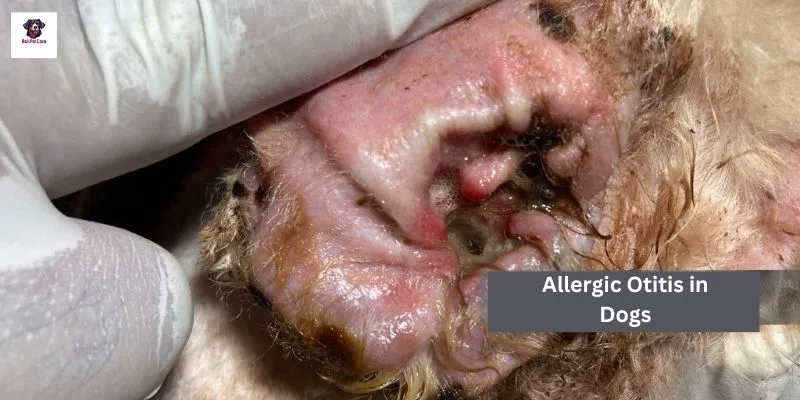
If we don’t take care of allergic otitis, it can get worse. It might even lead to infections in their ears, which can be really painful for them. Plus, if we don’t treat it early, it could cause permanent damage to their ears, and nobody wants that for their furry friend.
But if we understand what causes allergic otitis and how to deal with it, we can help our dogs feel better and stay healthy. That means figuring out what stuff makes them allergic, like certain foods or things in the environment, and keeping them away from those things as much as possible.
When we see any signs of allergic otitis, like scratching their ears a lot or shaking their head, we should take them to the vet right away. The vet can give them the right medicine and advice to help them feel better quickly.
So, by knowing about allergic otitis and doing what we can to manage it, we can make sure our furry friends are happy and comfortable, without those pesky ear troubles bothering them.
Now understand the main Causes of Allergic Otitis in Dogs:
Understanding what causes allergic otitis in dogs is crucial for effective management. Let’s delve into the triggers of allergic reactions and the common allergens that can lead to otitis.
Explanation of Allergic Reactions in Dogs:
When a dog’s immune system overreacts to certain substances, it triggers an allergic reaction. In allergic otitis, this reaction occurs in response to allergens that come into contact with the ears. The immune system mistakenly identifies these substances as harmful invaders and mounts a defensive response, leading to inflammation and irritation in the ears.
Common Allergens Leading to Otitis:
Environmental Allergens:
Pollen from trees, grasses, and weeds.
Dust mites are found in household dust.
Mold spores are present in damp environments.
Food Allergens:
Ingredients commonly associated with food allergies in dogs, such as beef, chicken, dairy, wheat, soy, and corn.
Contact Allergens:
Substances that come into direct contact with the skin or ears such as certain cleaning products, shampoos or topical medications.
Flea Allergy Dermatitis (FAD):
Allergic reaction to flea saliva following flea bites leads to intense itching and inflammation.

Atopy:
Genetic predisposition to environmental allergies often manifests as skin or ear problems in dogs.
Bacterial Infections:
Secondary bacterial infections can exacerbate allergic otitis or contribute to chronic ear inflammation.
Yeast Infections:
The overgrowth of yeast organisms in the ears is often secondary to underlying allergies or moisture buildup.
Foreign Bodies:
The presence of foreign objects, such as plant material or debris, in the ear canal, can trigger irritation and inflammation.
Ear Mites (Otodectes cynotis):
Parasitic mites infest the ears, causing intense itching and inflammation, especially in younger dogs or those living in crowded environments.
Autoimmune Disorders:
Conditions where the immune system mistakenly attacks the body’s tissues potentially leading to chronic inflammation in the ears.
Conclusion:
By recognizing the diverse collection of allergens and factors that can contribute to allergic otitis in dogs, veterinarians, and pet owners can take proactive steps to identify and mitigate these triggers.
here’s the information presented in a simple table format:
| Cause | Description |
| Environmental Allergens | Allergens like pollen, dust mites, and mold spores are found in the environment, causing allergic reactions in dogs’ ears |
| Food Allergens | Ingredients in food such as beef, chicken, dairy, wheat, soy, and corn that can trigger allergic responses |
| Contact Allergens | Substances that directly touch the skin or ears, like certain cleaning products or shampoos |
| Flea Allergy Dermatitis (FAD) | Allergic reaction to flea saliva after flea bites, leading to intense itching and inflammation |
| Atopy | Genetic predisposition to environmental allergies, often causing skin or ear problems in dogs |
| Bacterial Infections | Secondary infections that worsen allergic otitis or contribute to chronic ear inflammation |
| Yeast Infections | Overgrowth of yeast organisms in the ears, often due to underlying allergies or moisture buildup |
| Foreign Bodies | The presence of foreign objects like plant material or debris in the ear canal, triggers irritation and inflammation |
| Ear Mites (Otodectes cynotis) | Parasitic mites infest the ears, causing itching and inflammation, especially in younger dogs or crowded environments |
| Autoimmune Disorders | Conditions where the immune system mistakenly attacks the body’s tissues, potentially leading to chronic ear inflammation |
Now understand the main Symptoms of Allergic Otitis in Dogs:

Recognizing the signs of allergic otitis is essential for early intervention and management.
- Excessive Scratching:
- Dogs with allergic otitis often scratch their ears excessively, attempting to alleviate the itchiness caused by inflammation.
- Head-Shaking:
- Another common sign is vigorous head shaking, as dogs try to dislodge debris or relieve discomfort in their ears.
- Ear Rubbing or Pawing:
- Dogs may rub or paw at their ears in an attempt to soothe the irritation or discomfort caused by allergic otitis.
- Ear Redness and Swelling:
- The affected ear(s) may appear red, inflamed, or swollen due to the underlying inflammation associated with allergic otitis.
- Foul Odor from the Ears:
- Allergic otitis can lead to the production of abnormal ear discharge, which may emit a foul odor, indicating the presence of infection or inflammation.
- Ear Discharge:
- Dogs with allergic otitis may have increased production of ear discharge, which can be yellowish, brownish, or blackish, depending on the severity and underlying cause.
- Sensitivity or Pain:
- Dogs may exhibit signs of discomfort or pain when the affected ears are touched or manipulated, indicating inflammation or infection.
- Tilting of the Head:
- Some dogs with allergic otitis may tilt their heads to one side or hold their heads at an abnormal angle, reflecting inner ear involvement or vestibular dysfunction.
- Loss of Balance or Coordination:
- In severe cases, allergic otitis can affect the dog’s balance and coordination, leading to stumbling, falling, or difficulty walking.
- Changes in Behavior:
- Dogs may display changes in behavior, such as irritability, restlessness, or reluctance to eat or play, as a result of discomfort associated with allergic otitis.
Conclusion:
By being vigilant for these ten symptoms of allergic otitis in dogs, pet owners can promptly seek veterinary care and implement appropriate treatment measures to alleviate discomfort, prevent complications, and improve their furry companions’ quality of life.
Now understand the main Diagnosis of Allergic Otitis in Dogs:
Understanding how veterinarians diagnose allergic otitis is crucial for ensuring effective treatment and management. Let’s explore the methods veterinarians use and the importance of professional evaluation for accurate diagnosis.
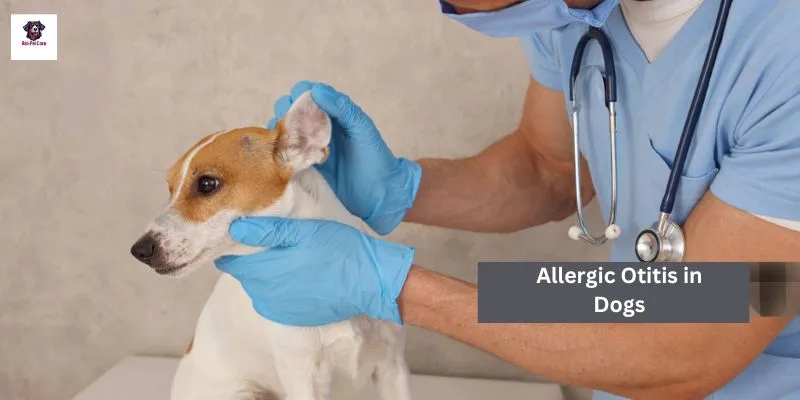
- Physical Examination:
- Veterinarians begin by conducting a thorough physical examination of the dog, paying close attention to the ears. They may observe signs of inflammation, discharge, redness, swelling, or odor.
- Otoscopic Examination:
- Using a specialized tool called an otoscope, veterinarians carefully examine the inside of the ear canal and eardrum. This allows them to assess the extent of inflammation, the presence of debris or foreign objects, and signs of infection.
- Ear Cytology:
- A sample of ear discharge or debris may be collected and examined under a microscope. Ear cytology helps veterinarians identify the type of microorganisms present (such as bacteria or yeast) and assess the severity of inflammation.
- Skin Allergy Testing:
- In cases where environmental or food allergies are suspected as the underlying cause of allergic otitis, veterinarians may recommend skin allergy testing to identify specific allergens triggering the dog’s allergic reactions.
- Intradermal Allergy Testing:
- Intradermal allergy testing involves injecting small amounts of potential allergens into the dog’s skin and monitoring for allergic reactions. This helps pinpoint specific allergens contributing to allergic otitis.
- Food Elimination Trial:
- A food elimination trial involves feeding the dog a novel, hypoallergenic diet for a specified period while monitoring for improvements in allergic symptoms. This helps identify and eliminate potential food allergens causing allergic otitis.
- Dermatological Examination:
- In cases where allergic skin conditions are concurrent with allergic otitis, veterinarians may conduct a thorough dermatological examination to assess the dog’s overall skin health and identify any underlying dermatological issues.
- Imaging Studies:
- In severe or complicated cases of allergic otitis, veterinarians may recommend imaging studies such as radiographs (X-rays) or computed tomography (CT scans) to evaluate the extent of ear inflammation or assess for underlying structural abnormalities.
- Allergy Blood Testing:
- Blood tests measuring allergen-specific IgE antibodies may be used to identify potential allergens triggering allergic reactions in dogs with allergic otitis.
- Response to Treatment:
– Response to treatment serves as an important diagnostic tool. If the dog’s symptoms improve with appropriate treatment (such as ear medications, dietary changes, or allergen avoidance), it provides further evidence supporting the diagnosis of allergic otitis.
Importance of Professional Evaluation:
Professional evaluation by a veterinarian is essential for accurate diagnosis of allergic otitis in dogs. Veterinarians have the expertise and resources to perform a comprehensive assessment, identify underlying causes, and tailor treatment plans to address the specific needs of each dog. Early diagnosis and intervention can alleviate discomfort, prevent complications, and improve the dog’s overall well-being.
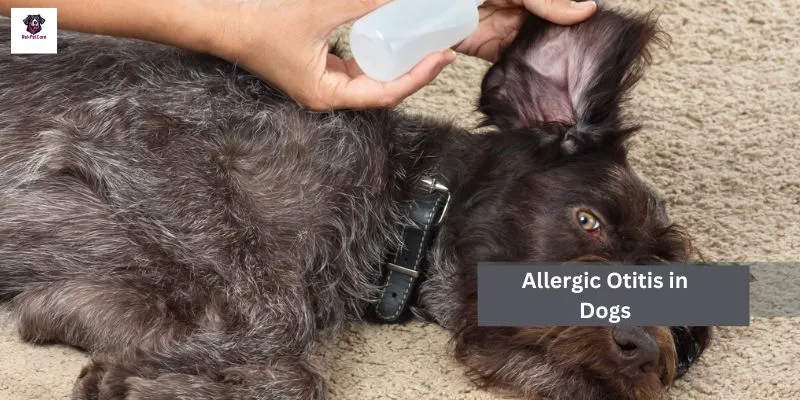
Now understand the Treatment Options for Allergic Otitis in Dogs:
- Medication is commonly used.
Antibiotics: If secondary bacterial infections are present, antibiotics may be prescribed to treat the infection and prevent further complications.
Antibiotics:
- Cephalexin (Keflex): Cephalexin is a broad-spectrum antibiotic that effectively treats bacterial infections commonly associated with allergic otitis. It works by inhibiting the growth of bacteria, thereby resolving the infection and preventing further complications.
- Enrofloxacin (Baytril): Enrofloxacin is a fluoroquinolone antibiotic with activity against a wide range of bacterial pathogens commonly implicated in otitis. It is available in both oral and injectable forms, providing flexibility in treatment options.
- Clindamycin (Antirobe): Clindamycin is an antibiotic that targets anaerobic bacteria and is often used in cases where secondary infections with these organisms are present. It is available in various formulations, including oral capsules and liquid suspensions.
Antifungals: In cases of concurrent yeast infections, antifungal medications may be necessary to combat fungal overgrowth.
Antifungals:
- Ketoconazole (Nizoral): Ketoconazole is an antifungal medication that effectively treats yeast infections commonly seen in conjunction with allergic otitis. It works by inhibiting the growth of fungi and restoring the balance of microorganisms in the ear canal.
- Miconazole (Miconosol): Miconazole is an antifungal agent available in various formulations, including ear drops and topical creams. It is effective against a wide range of fungal species and helps alleviate itching and inflammation associated with yeast infections.
- Clotrimazole (Canesten): Clotrimazole is an antifungal medication commonly used to treat yeast infections in the ears. It works by disrupting the fungal cell membrane, leading to cell death and resolution of the infection.
Corticosteroids: These medications help reduce inflammation and alleviate itching, providing relief from allergic otitis symptoms.
Corticosteroids:
- Prednisone: Prednisone is a commonly prescribed corticosteroid that helps reduce inflammation and alleviate itching associated with allergic otitis. It works by suppressing the immune response and reducing the production of inflammatory mediators.
- Dexamethasone: Dexamethasone is a potent corticosteroid with anti-inflammatory and immunosuppressive properties. It is often used in cases of severe inflammation or acute exacerbations of allergic otitis to provide rapid relief of symptoms.
- Hydrocortisone: Hydrocortisone is a mild corticosteroid available in various formulations, including ear drops and topical creams. It helps alleviate itching and inflammation in the ears and is often used as adjunctive therapy in the management of allergic otitis.
Antihistamines: Some dogs may benefit from antihistamines to help control allergic reactions and minimize itching.

Antihistamines:
- Diphenhydramine (Benadryl): Diphenhydramine is a first-generation antihistamine commonly used to relieve itching and allergic symptoms in dogs. It works by blocking the effects of histamine, a chemical involved in allergic reactions.
- Cetirizine (Zyrtec): Cetirizine is a second-generation antihistamine with fewer sedative effects compared to older antihistamines. It is effective in controlling itching and allergic symptoms associated with allergic otitis.
- Loratadine (Claritin): Loratadine is another second-generation antihistamine that provides relief from itching and allergic symptoms without causing drowsiness. It is well-tolerated in dogs and suitable for long-term use in the management of allergic otitis.
Immunotherapy (Allergy Shots): Immunotherapy involves administering allergens in gradually increasing doses to desensitize the dog’s immune system and reduce allergic reactions over time.
Immunotherapy (Allergy Shots):
- Sublingual Immunotherapy (SLIT): Sublingual immunotherapy involves administering allergens in the form of drops or tablets placed under the dog’s tongue. Over time, repeated exposure to small amounts of allergens helps desensitize the immune system and reduce allergic reactions.
- Allergen-Specific Immunotherapy (ASIT): Allergen-specific immunotherapy involves injecting allergens subcutaneously (under the skin) at gradually increasing doses. This approach helps modify the immune response and reduce sensitivity to specific allergens associated with allergic otitis.
- Oral Immunotherapy (OIT): Oral immunotherapy involves administering allergens orally, typically in the form of capsules or solutions. This approach aims to induce immune tolerance to allergens and reduce allergic reactions over time.
- Ear Cleaning:
- Regular ear cleaning with veterinarian-recommended ear cleaners helps remove debris, wax buildup, and excess moisture, reducing the risk of infections and improving medication penetration.
- Epi-Otic Advanced Ear Cleaner:
- Use: Epi-Otic Advanced Ear Cleaner is a widely used ear cleaning solution for dogs. It helps remove debris, wax buildup, and excess moisture from the ear canal. The solution has a mild cleansing action and helps soothe irritated ears. It can be used routinely as part of regular ear maintenance or as directed by a veterinarian to prepare the ear canal for medication application.
- Virbac Epi-Soothe Ear Cleanser:
- Use: Virbac Epi-Soothe Ear Cleanser is another veterinarian-recommended ear-cleaning solution suitable for dogs with sensitive ears. It is designed to gently cleanse the ear canal, remove debris, and provide relief from irritation. The soothing properties of the solution help maintain ear health and improve medication penetration. It can be used as part of a regular ear care routine or as directed by a veterinarian to maintain ear cleanliness and prevent infections.
3. Topical Medications:
- Topical ear medications, such as ear drops or ointments containing antibiotics, antifungals, or corticosteroids, may be prescribed to address inflammation and infection directly in the ear canal.
- Dietary Management:
- Switching to a hypoallergenic or limited-ingredient diet can help identify and eliminate potential food allergens causative to allergic otitis. A veterinarian may recommend a specific diet tailored to the dog’s needs.
- Allergen Avoidance:
- Identifying and minimizing exposure to environmental allergens, such as pollen, dust, or mold, can help reduce allergic reactions and alleviate symptoms. This may involve lifestyle changes, such as keeping the dog indoors during peak pollen seasons or using air purifiers.
- Flea Control:
- Implementing strict flea control measures, including regular use of flea preventatives and maintaining a clean environment, helps prevent flea allergy dermatitis (FAD) and reduces the risk of secondary otitis.
- Environmental Modifications:
- Making environmental modifications, such as reducing exposure to potential irritants like cigarette smoke or strong perfumes can help minimize allergic triggers and improve the dog’s comfort.
- Moisture Control:
- Keeping the ears dry and well-ventilated can help prevent moisture buildup, which creates a favorable environment for yeast and bacterial growth. Avoiding water activities or using ear drying solutions may be beneficial.
- Regular Veterinary Monitoring:
- Regular check-ups with a veterinarian are essential for monitoring the dog’s progress, adjusting treatment plans as needed, and addressing any emerging issues promptly.
- Lifestyle Adjustments: – Making lifestyle adjustments, such as providing regular exercise, maintaining a balanced diet, and reducing stress, supports the dog’s overall health and immune function, potentially reducing the severity of allergic otitis symptoms.
Importance of Addressing the Underlying Allergy:
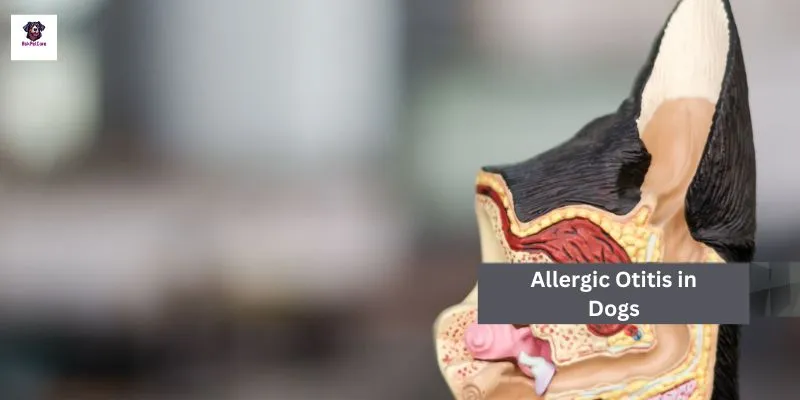
While symptomatic treatment is vital for managing allergic otitis, addressing the underlying allergy is dominant for long-term control and prevention of recurrence. Identifying and minimizing exposure to allergens through environmental controls, dietary management, and allergen-specific immunotherapy helps reduce the dog’s sensitivity and minimize allergic reactions, leading to improved quality of life and long-term management of allergic otitis.
Certainly, here are two examples of veterinarian-recommended ear cleaners along with their uses:
Different Methods for Prevention of Allergic Otitis in GSD Dogs:
Taking proactive steps to prevent allergic otitis in dogs is essential for maintaining their ear health and overall well-being. Here are several tips and environmental management strategies to reduce the risk of allergic reactions and minimize the occurrence of otitis:
-
- 1. Identify and Avoid Allergens:
Work with your veterinarian to identify potential allergens triggering allergic reactions in your dog. Common allergens include pollen, dust mites, mold, certain foods, and environmental irritants. Once identified, take steps to minimize your dog’s exposure to these allergens.
-
- 2. Regular Grooming:
Maintain a regular grooming routine to keep your dog’s coat clean and free from allergens. Regular baths with veterinarian-recommended shampoos can help remove allergens from the skin and coat, reducing the risk of allergic reactions.
-
- 3. Food Allergy Management:
If your dog has food allergies contributing to allergic otitis, work with your veterinarian to identify and eliminate potential trigger ingredients from their diet. Transition to hypoallergenic or limited-ingredient diets to minimize the risk of allergic reactions in GSD.
-
- 4. Flea Prevention:
Implement a comprehensive flea prevention program to protect your dog from flea infestations and flea allergy dermatitis (FAD). Use veterinarian-recommended flea control products regularly and maintain a clean living environment to minimize the risk of flea exposure.
-
- 5. Environmental Controls:
Make environmental modifications to reduce your dog’s exposure to common allergens. Keep indoor environments clean and well-ventilated, use air purifiers to remove airborne allergens, and minimize outdoor activities during peak pollen seasons.
-
- 6. Regular Ear Maintenance:
Incorporate regular ear cleaning into your dog’s grooming routine to prevent wax buildup, moisture accumulation, and debris accumulation in the ear canal. Use veterinarian-recommended ear cleaners and follow proper ear-cleaning techniques to maintain ear health.
-
- 7. Allergy Testing:
Consider allergy testing to identify specific allergens triggering allergic reactions in your dog. Skin allergy testing or blood allergy testing can help pinpoint allergens, allowing for targeted allergen avoidance strategies and immunotherapy if necessary.
-
- 8. Minimize Moisture:
Minimize moisture buildup in your dog’s ears by drying their ears thoroughly after bathing or swimming. Avoid leaving wet ear hair or excessive moisture in the ear canal, as it creates a favorable environment for yeast and bacterial growth.
-
- 9. Reduce Stress:
Minimize stressors that may exacerbate allergic reactions in your dog. Provide a calm and comfortable living environment, maintain a consistent routine, and address any underlying behavioral or environmental stressors that may contribute to allergic otitis.
-
- 10. Regular Veterinary Check-ups: – Schedule regular veterinary check-ups for your dog to monitor their ear health and overall well-being. Veterinarians can provide preventive care, perform ear examinations, and offer guidance on managing allergies to prevent allergic otitis. Regular check-ups allow for early detection and intervention if any issues arise.
By implementing these preventive measures and environmental management strategies, you can help reduce the risk of allergic otitis in your dog and promote their ear health and comfort. Regular communication with your veterinarian is key to developing an effective preventive care plan tailored to your dog’s individual needs.
Now discussed are the Complications and Prognosis of Allergic Otitis in Dogs:
Understanding the potential complications associated with untreated allergic otitis and the long-term outlook for dogs with properly managed allergic otitis is crucial for pet owners. Here are several options to consider:
Potential Complications of Untreated Allergic Otitis:
- Chronic Inflammation: Persistent inflammation in the ears due to untreated allergic otitis can lead to chronic otitis external or otitis media, increasing the risk of secondary infections and structural damage to the ear canal and middle ear.
- Secondary Infections: Untreated allergic otitis creates an ideal environment for bacterial or yeast overgrowth, leading to secondary infections that can exacerbate inflammation, cause pain, and impair hearing.
- Ear Hematomas: Excessive scratching or head shaking associated with untreated allergic otitis can lead to the development of ear hematomas, which are painful blood-filled swellings within the ear flap.
- Eardrum Rupture: Severe inflammation and recurrent infections in the middle ear can result in eardrum rupture, leading to hearing loss and increased susceptibility to further infections.
- Chronic Pain: Chronic inflammation and recurrent infections associated with untreated allergic otitis can cause persistent pain and discomfort for affected dogs, significantly impacting their quality of life.
- Structural Damage: Long-standing inflammation and infections can cause structural damage to the ear canal, leading to narrowing (stenosis), scarring, or abnormal tissue growth (hyperplasia), potentially requiring surgical intervention.
- Systemic Spread of Infection: In severe cases, untreated ear infections can spread beyond the ear canal, leading to systemic complications such as abscess formation, cellulitis, or septicemia.
- Behavioral Changes: Dogs experiencing chronic pain or discomfort from untreated allergic otitis may exhibit changes in behavior, including aggression, withdrawal, or reluctance to interact with humans or other pets.
- Decreased Quality of Life: The cumulative effects of chronic inflammation, pain, and recurrent infections associated with untreated allergic otitis can significantly diminish a dog’s overall quality of life, affecting their ability to enjoy daily activities and interactions.
- Increased Healthcare Costs: The management of complications arising from untreated allergic otitis, such as secondary infections or surgical interventions, can result in increased healthcare costs for pet owners.
-

Allergic Otitis in Dogs
Long-Term Outlook for Dogs with Properly Managed Allergic Otitis:
- Improved Comfort: Proper management of allergic otitis can alleviate discomfort, reduce inflammation, and improve overall comfort for affected dogs, enhancing their quality of life.
- Reduced Risk of Complications: By addressing underlying allergies, implementing preventive measures, and following a comprehensive treatment plan, dogs with properly managed allergic otitis are less likely to experience complications such as secondary infections or structural damage to the ears.
- Enhanced Hearing: Effective management of allergic otitis can help preserve hearing function and prevent complications such as eardrum rupture or middle ear damage, ensuring optimal auditory health for affected dogs.
- Minimized Recurrence: With appropriate ongoing care, including regular ear maintenance, allergen avoidance, and veterinary monitoring, dogs with properly managed allergic otitis can experience fewer episodes of recurrence and enjoy long-term symptom control.
- Improved Prognosis: Dogs with properly managed allergic otitis have a favorable long-term prognosis, with the potential for a happy, healthy life free from the discomfort and complications associated with untreated ear conditions.
- Better Quality of Life: By addressing allergic otitis proactively and ensuring consistent management, pet owners can help their furry companions lead fulfilling lives with minimal disruptions from ear-related issues.
- Reduced Healthcare Costs: Preventing complications through proper management of allergic otitis can result in reduced healthcare costs for pet owners over the long term, as fewer veterinary visits, medications, and interventions may be required.
- Enhanced Bond with Pet Owners: Effective management of allergic otitis fosters a strong bond between pet owners and their dogs, as owners play an active role in their pet’s care and well-being, leading to a deeper connection and mutual trust.
- Optimized Overall Health: By addressing allergic otitis comprehensively and addressing underlying allergies, pet owners can promote their dog’s overall health and well-being, supporting their immune system and reducing the risk of other allergic conditions or related health issues.
- Extended Lifespan: Properly managed allergic otitis can contribute to an extended lifespan for affected dogs, as they are less susceptible to complications and secondary health problems associated with untreated ear conditions.
understanding the potential complications of untreated allergic otitis underscores the importance of timely diagnosis and comprehensive management. With proper care, dogs with allergic otitis can enjoy a favorable long-term outlook, improved quality of life, and enhanced overall health.
Here’s the information presented in a simple table format:
Potential Complications of Untreated Allergic Otitis in German Shepherd dog:
| Complication | Description |
| Chronic Inflammation | Persistent inflammation in the ears leads to chronic otitis external or otitis media. |
| Secondary Infections | Bacterial or yeast overgrowth due to untreated otitis leads to recurrent infections. |
| Ear Hematomas | Painful blood-filled swellings within the ear flap are caused by excessive scratching or head shaking. |
| Eardrum Rupture | Severe inflammation and infections may lead to eardrum rupture, causing hearing loss. |
| Chronic Pain | Persistent discomfort for affected dogs, impacting their quality of life. |
| Structural Damage | Damage to the ear canal requiring surgical intervention. |
| Systemic Spread of Infection | Spread of infection outside the ear canal to other parts of the body. |
| Behavioral Changes | Changes in behavior due to chronic pain or discomfort. |
| Decreased Quality of Life | Diminished overall quality of life for affected dogs. |
| Increased Healthcare Costs | Higher costs associated with managing complications from untreated otitis. |
Long-Term Outlook for Dogs with Properly Managed Allergic Otitis:
| Outcome | Description |
| Improved Comfort | Alleviation of discomfort and enhanced quality of life for affected dogs. |
| Reduced Risk of Complications | Lower likelihood of experiencing secondary infections or structural damage. |
| Enhanced Hearing | Preservation of hearing function and prevention of complications. |
| Minimized Recurrence | Fewer episodes of recurrence with consistent management. |
| Improved Prognosis | The favorable long-term outlook for dogs with proper management. |
| Better Quality of Life | Enhanced well-being and fewer disruptions from ear-related issues. |
| Reduced Healthcare Costs | Lower overall healthcare costs for pet owners. |
| Enhanced Bond with Pet Owners | Strengthened bond between pet owners and their dogs. |
| Optimized Overall Health | Promotion of overall health and well-being in affected dogs. |
| Extended Lifespan | Contribution to an extended lifespan for dogs with properly managed otitis. |
These tables provide a straightforward comparison of the potential complications of untreated allergic otitis and the long-term outlook for dogs with properly managed allergic otitis.
I hope you will thoroughly understand about the Allergic Otitis in Dogs still any quarry contact me.
What causes allergic otitis in dogs?
Allergic otitis in dogs is commonly caused by environmental allergens, food allergies, or contact allergens like certain cleaning products.
How do you treat allergic otitis in dogs?
Treatment options for allergic otitis in dogs include medication such as antibiotics and corticosteroids, ear cleaning, allergen avoidance, and immunotherapy.
What are the symptoms of allergic otitis in dogs?
Symptoms of allergic otitis in dogs include excessive scratching, head shaking, ear rubbing, redness and swelling of the ears, foul odor, ear discharge, sensitivity or pain, tilting of the head, loss of balance, and changes in behavior.
Can allergic otitis in dogs lead to complications?
Yes, untreated allergic otitis in dogs can lead to complications such as chronic inflammation, secondary infections, ear hematomas, eardrum rupture, structural damage, systemic spread of infection, chronic pain, decreased quality of life, and increased healthcare costs.
How can I prevent allergic otitis in my dog?
Preventing allergic otitis in dogs involves identifying and avoiding allergens, regular grooming, food allergy management, flea prevention, environmental controls, regular ear maintenance, allergy testing, minimizing moisture, reducing stress, and regular veterinary check-ups.
Here are some reference books that are considered authoritative on the topic:
These books cover a range of topics related to dermatology and skin diseases in dogs, including diagnosis, treatment, and management of skin conditions.
- “Muller and Kirk’s Small Animal Dermatology” by William H. Miller Jr. DVM DACVD, Craig E. Griffin DVM DACVD, Karen L. Campbell DVM DACVD :
- “Skin Diseases of the Dog and Cat” by Nicole A. Heinrich DVM DACVD, Melissa Eisenschenk DVM DACVD – :
- “Canine and Feline Dermatology Drug Handbook” by Sandra N. Koch DVM MS DACVD, Cheryl S. Hedlund DVM MS DACVD :
Disclaimer: This information is general advice only. Before starting any treatment or supplement with your pet, please consult your vet first for the best approach to getting your pet back to its best health.
Check with your veterinarian before giving any medication or supplement at home, to be sure it’s safe for your pup. Some substances can be toxic or harmful, including “dog-safe” medications and supplements if they are given at the wrong dosage.
